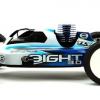-
Posts
192 -
Joined
-
Last visited
About DLD
- Birthday 04/04/1965
Profile Information
-
Gender
Male
-
Location
Luxembourg, the Grand Duchy.
-
RC Cars
TLR 8ight 3.0 kit with Picco Boost 5TR power -- Modded Hobao Hyper 7 with LRP ZR.30X power
-
How did you find this forum?
internet
-
eBay Username
dimi1199
Recent Profile Visitors
3,886 profile views
DLD's Achievements
-
Is this fixed? Do you still need help ?
-
Hello there, OS #8 plugs fit perfectly on a Hyper .21 3-Port nitro engine. It is a standard size .21 glow plug. It is a very good choice as well, according to lots of users. The T4 Turbo Platinum Glow Plug you refer to is a "TURBO" glow plug. It will not fit your Hyper .21 3-port. See pictures of both plugs below and spot the obvious difference between the 2.
-
Success ! I installed the FS-iA4B receivers in 2 of my buggies and I am happy to say that they both run at 8.4 volts without any problems. "Internal voltage 1" below, is the receiver's battery voltage" So for everybody out there, although these receivers are advertised to operate at 4.0 - 6.5 volts, they are working OK with 2s lipo packs.
-
Good idea. Damn, why didn't I think about this until now? Yep, I think I might do just that over this weekend. Smoke or no-smoke, I shall report back with the results lol .
-
Thanks for your input, I appreciate your answer. The thing is, if I do that the high-voltage servos I use lose their speed and torque performance. I mean it would be sad for somebody to pay the extra cash in order to get fast and powerful HV servos, then use a BEC to drop the voltage on them . . . I've also learned not to trust BEC's. I find it creates a lot of heat (that's how the excess voltage is bled, with a simple transistor, it goes up as heat). I have also seen one create a fire on a Kyosho. It went up in flames like a bag of cotton, lol. My before-last alternative is FS-GR3E receivers. I own some of these old receivers and I am sure they work with up to 8.4 Volts DC (I have used them for months without an issue). They will pair and work with my FS-iT4S TRX. It is just that their latency is not that fast (AFHDS versus AFHDS-2A technology). And I suppose my absolute last alternative is to connect an FS-iA4B receiver up with the lipo, switch everything on and look for the trail of smoke . . .
-
I am looking for some time for an answer on this subject and i cannot find a clear one, so here is my question. Trying to upgrade to a FlySky FS-iT4S transmitter, driving my 1:8 buggies. The receiver that came with it is an FS-iA4B receiver. I need to buy some more of these for all my cars. http://www.flysky-cn.com/products_detail/productId=46.html On FlySky's website, as well as on all other sites that list this receiver, they define its operating voltage between 4.0 - 6.5 Volts DC. But on my 2 buggies I use 2 shell LiFE batteries and my son uses a 2s lipo on his Losi 8ight 3.0 nitro. A fully charged 2S LiFE reaches 7.2 volts and a fully charged 2S Lipo pack tops at 8.4 volts. So here goes the question: Did anybody out there ever tried to power one of these receivers (FS-iA4B) at 7.2 or 8.4 volts DC? Are they compatible, or will they burn out? Thanks in advance for an answer on this and best regards, FlySky_Tx_Rx_compatibility_table.pdf
-
You are mostly welcome. _
-
_. Make sure you are running proper (not worn out) tires. The rubber on all 4 corners is the most important factor of your setup. _. Next thing to check is Droop. If you have a lot of front droop, all your weight is being shifted to the rear when you are on the throttle, unloading weight from the front tires, so your steering is mostly gone. Remember, front and rear droop settings is a great way to balance on and off power traction. _. Ride height. Raise the rear of your car. Make sure the car front is 2 - 3 mm lower than the rear. _. Springs and oil can also affect front and rear weight transfer on and off the throttle. If you put on super soft springs and light oil, you will get a ton of weight transfer front and back, amplifying on-power understeer and off power oversteer. Try thicker oil and/or stiffer springs at the rear = more on power steering. _. Stand the Rear Shocks up straighter. Hope this helped you and gave you some new ideas.
-
I am always trying to buy nitro fuel in 2.5 liter containers (bottles). Like that , I only open and completely use 1 bottle a day, I never leave any opened nitro bottle for the next day. It is a bit more expensive (depending what /where you buy) but I believe this prevents nitro fuel from going bad, or having leaks from storing already opened nitro bottles. So, buy nitro fuel in containers that you can completely use on your every bashing / racing session and limit nitro fuel contact with air. That works for me.
-
Attached is the engine manual. Factory settings for the mach .28 engine: LSN: 2 full turns from fully closed HSN: 3 1/2 full turns from fully closed DYN_mach28_manua.pdf
-
You should fully re-tune the engine after you change the clutch bell. Be careful with the high needle settings. Make sure the engine comes to a steady idle after you release the throttle from WOT and stays there. If the RPM stays high after you release the throttle, after a full power run, richen the HSN. If the engine immediately dies after the throttle is released, check the engine temp. If too hot, richen the HSN half a turn, cool it down and re-tune. Too lean and too long WOT runs can overheat/damage your engine. Do not ask how I found this out lol
-
Hello there, If I were you, I would go one clutch bell tooth up from the standard installed. You will gain some speed, but your acceleration will suffer a bit because of it. I would say that going from a 13t bell to a 17t one, is way too much for the Hyper .21 engine. Are you bashing with it, or you want to race it? Do you have long enough straight(s) on your track to get to that speed? I would try some laps and see if the top speed gain with the bigger clutch bell is worth it, as it will take more time to reach that speed . . . If you want to see how fast it can go on a long straight (bashing) go for a 15t bell. I would not recommend a bigger size though. I hope that helps you.
-
Your speed sensor counts wheel RPM. But if you define for it your wheel rotational length, then it knows how far you have travelled and it knows time, so you get MPH out of it. Just trying to help. _
-
The rotational length of a wheel is its circumference. Rotational length is the distance a wheel has travelled after one full wheel rotation. To calculate that: Circumference C=πd, or C=2πr. π = 3.14 d= diameter of the wheel r = radius of a wheel. So, if you multiply your wheel diameter X 3.14 you have the rotational length of your wheel. For example, my 1:8 buggy wheel/tire has a diameter of 112 mm. So, 112 mm X 3.14 = 351.68 mm. Therefore, the rotational length of my buggy tire is 35,16 cm. To make it more complicated: The relationship between radius, diameter, circumference, revolutions and distance for a wheel can be calculated by using the formula on the site below: https://rechneronline.de/wheel/ I hope this helped.
-
Just an idea mate, Did you try lightly tapping your transmitter with your hand while it is on? Does it momentarily loose power maybe? Maybe shake the transmitter while driving and see if the car looses signal again? Not trying to be smart, it has happened to me before. Just my 2p. _












